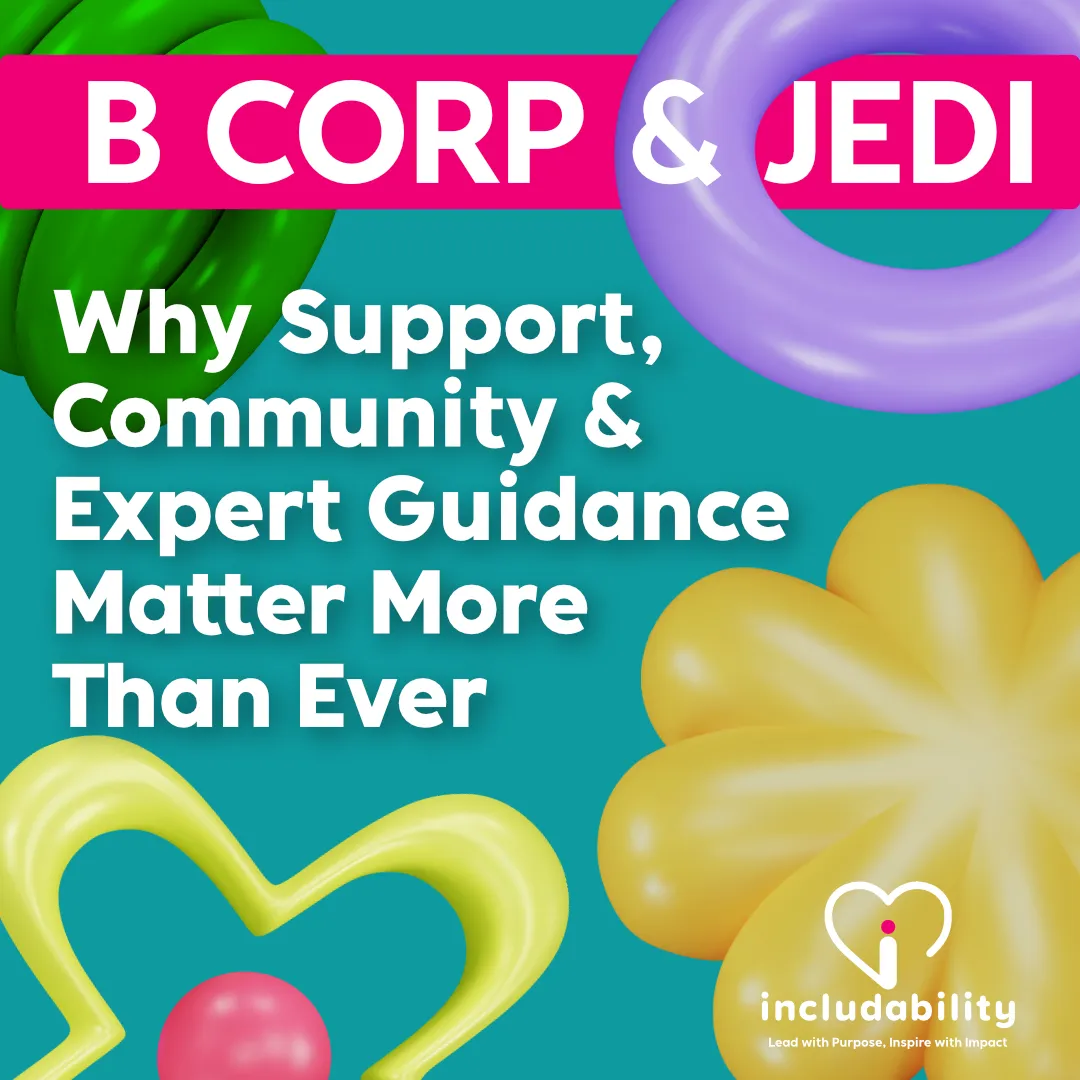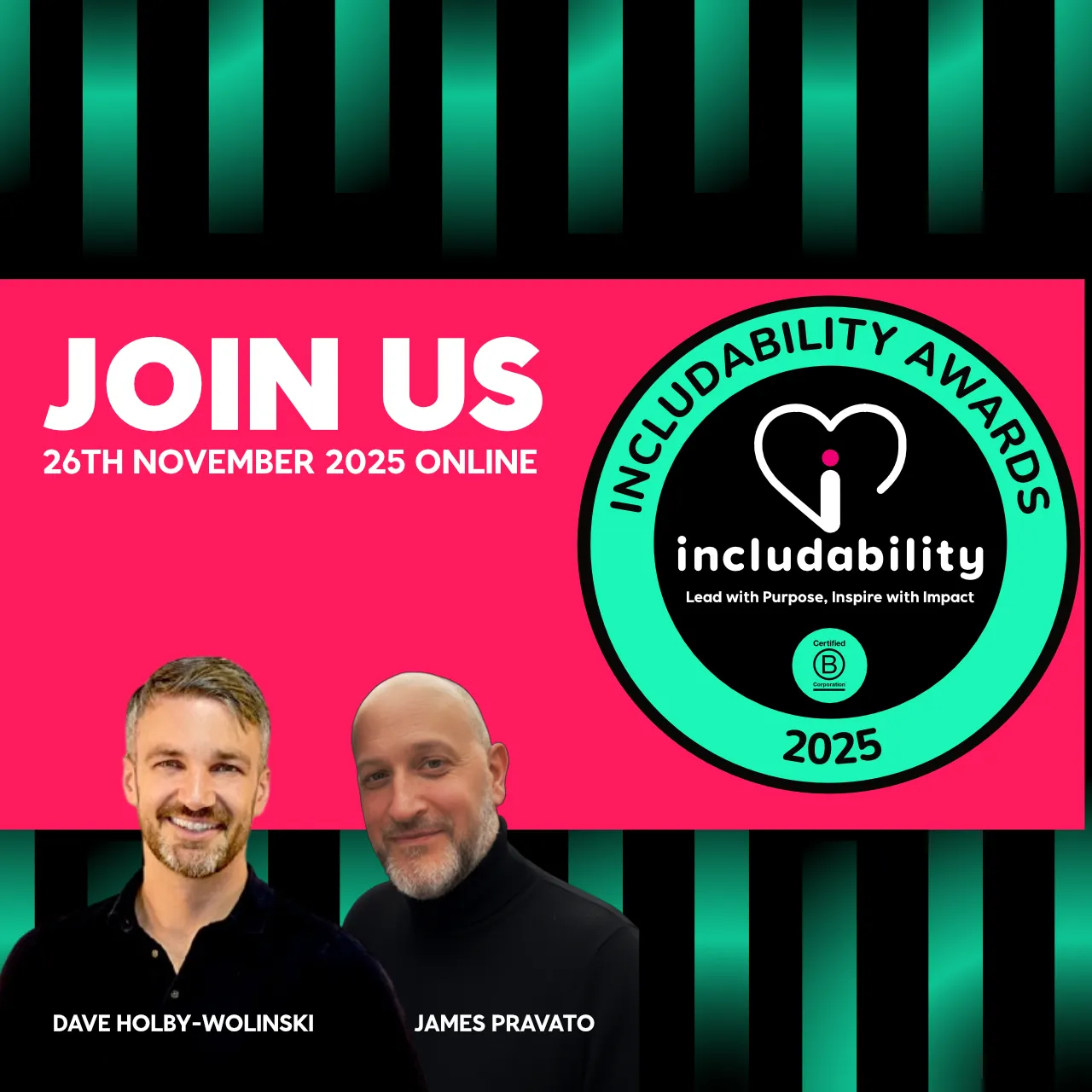How to develop EDI Policy Strategies
National Inclusion Week 2024 is a time dedicated to celebrating diversity, promoting inclusion, and raising awareness about the importance of creating a more inclusive society. These blogs to help guide you through everything you need to know about National Inclusion Week, from its origins and significance to how our community can help your organisation make a lasting impact. This blog is dedicated to the topics of EDI Goals and Policy Strategy.

A Handy Includability Spin Out Guide for National Inclusion Week 2024

National Inclusion Week 2024 is a time dedicated to celebrating diversity, promoting inclusion, and raising awareness about the importance of creating a more inclusive society.
This week, we have a series of blogs to help guide you through everything you need to know about National Inclusion Week 2024, from its origins and significance to how our community can help your organisation make a lasting impact.
This blog is dedicated to the topics of EDI Goals and Policy Strategy.
See our main blog - What is National Inclusion Week? - to find out more about National Inclusion Week and further strategy topics.
Setting Clear EDI Goals and Strategy Metrics
Establishing clear goals and measurable metrics is essential for any EDI strategy. These should align with the company’s values and business objectives, helping to drive tangible progress. Metrics such as diverse hiring, representation in leadership roles, and inclusion surveys allow organisations to track improvements, identify gaps, and hold themselves accountable. Regularly reviewing these goals ensures continuous growth and adaptation to evolving EDI needs.
As businesses evolve, regularly reviewing progress through impact reports can maintain momentum and accountability. Natalie Welsh of The TypeFace Group advocates for a structured approach, starting with clear goals and metrics for D&I that align with broader business objectives. She also highlights the importance of ongoing leader training, equitable hiring practices, and supplier diversity.
“To make a lasting impact on inclusion, businesses must go beyond one-time initiatives and embrace a comprehensive approach that embeds equity, diversity, and inclusion (EDI) into every aspect of their operations. Here are some strategies:
“1. Develop a Clear EDI Strategy - Define Goals and Metrics: Set specific, measurable goals for diversity and inclusion that align with the company's values and business objectives. This doesn't have to be too detailed for small businesses. It's similar to an impact report for sustainability. Acknowledge where you are and where improvements can be made in the next 12 months and go for them.
“Incorporate ED&I into Business Plans: Ensure that diversity and inclusion are integrated into the broader business strategy, not just HR policies. This includes language used in communications, for example.
“2. Foster Inclusive Leadership - Train Leaders on Inclusive Practices: Internal change only happens authentically if it comes from the top down. Provide ongoing training for leaders to understand and practice inclusive behaviours and then model them!
“3. Create Safe Spaces for Dialogue - Facilitate Open Conversations: Encourage employees to share their experiences and perspectives and ensure that these discussions lead to action.
“4. Inclusive Hiring and Advancement - Revise Recruitment Practices: Ensure job descriptions are free from bias, use diverse hiring panels, and consider blind recruitment processes. This means removing dates to repent ageism from CVs and even names to prevent gender or race bias at the screening level.
“Promote Equitable Advancement: Regularly review promotion and pay equity to ensure all employees have equal advancement opportunities.
“5. Community and Supplier Diversity - Engage with Diverse Suppliers: Actively seek out and partner with diverse suppliers, including those led by underrepresented groups.
“Community Engagement: Support initiatives in the communities where you operate that advance inclusion, such as educational programs, charity work or partnerships with local organisations.
“6. Sustainability of EDI Efforts - Long-Term Commitment: Ensure that EDI is a long-term commitment, with regular reviews and updates to policies and practices. A yearly impact report published publicly is a great way to keep on track.
“Celebrate Progress: Acknowledge and celebrate milestones while continuously striving for improvement.”
Natalie Welsh, Co-Founder, The TypeFace Group
Showcase Long-Term EDI Strategies
To create a lasting impact, EDI must be embedded in long-term business strategies rather than seen as a one-off initiative. Companies should commit to ongoing education, policy development, and action plans that continuously evolve. This includes setting multi-year goals for diversity hiring, leadership representation, and inclusion programmes.
Showcasing these strategies transparently, both internally and externally, demonstrates a genuine commitment to diversity and helps build trust with employees, clients, and partners. Sara Matthews, Owner of ODISEE Ltd, advises using National Inclusion Week to showcase continuous efforts, embedding inclusion into everyday practices rather than viewing it as a short-term campaign.
“The most lasting impact is to use the Inclusion Month as a showcase of the work being done in the business rather than the one time that inclusion is on the agenda. Using the month to showcase commitments and activities demonstrates to colleagues in a business how important inclusion is and that it is not a one off but fully embedded in the business.”
Sara Matthews, Owner of ODISEE Ltd
Commit Resources to EDI
Investing resources—both financial and human—into EDI initiatives is critical for driving meaningful change. Proper resource allocation demonstrates that a company views EDI as a business priority, not an afterthought, enabling sustained progress.
Employers should commit to inclusion by signing up for long-term programmes that promote understanding across various protected characteristics. Kirsty Dixon from Pause for Thought Consultancy adds that time and resources are essential to sustaining these initiatives.
“Give it the time and resources it needs. Signing up to initiatives which mean they show their commitment to inclusion and keep it live on agendas. Understand their workforce and what the different requirements are to ensure they are being inclusive to all, regardless of protected characteristics and beyond.”
Kirsty Dixon, Menopause Educator at Pause for Thought Consultancy
Holding Leaders Accountable for Inclusion and EDI Policy
Will Cleare of The HR Agency critiques the “E, D & I and done” mentality, where diversity initiatives are relegated to specialists. Instead, he asserts that accountability for a truly inclusive culture should rest with senior leadership, with inclusion as a core leadership responsibility.
"One area for improvement I'm aware of is 'E, D & I and done', adopted by some organisations. This sense that a Board or Exec have recognised the need to have some kind of E, D & I strategy, appoint an E, D & I specialist, often-times reporting into the HR line and then holding them responsible and accountable for the success or failure of EDI initiatives.
"The accountability for an inclusive culture should sit at the most senior level in the organisation and it should be a critical success factor for that role-holder."
Will Cleare, Founder of The HR Agency
Implement Structures for Support, Accountability & Trust in EDI Strategies
Creating formal structures for support and accountability is key to embedding EDI within an organisation.
Businesses need to be transparent about both their successes and areas for improvement, building trust and commitment. Diane Lightfoot of the Business Disability Forum underscores that inclusion requires creating a workplace where everyone feels they belong and can seek support.
“Inclusion isn’t a one-off event but about building a culture where everyone feels they belong, where they can ask for the support, they need and where the systems are in place to provide it. It’s important for businesses to take stock of where they have the biggest gaps, where they need to focus and where they can make the most impact. It’s also important to be transparent about what’s going well and what still needs to happen to build trust.”
Diane Lightfoot, CEO, Business Disability Forum
EDI Policies Frequently Overlooked by Business
One often overlooked aspect of EDI is the role that internal policies play in shaping inclusion. Policies regarding parental leave, flexible working, and reasonable adjustments for disabilities often fail to account for diverse needs.
Regularly reviewing and updating these policies ensures they remain equitable, creating a framework that supports all employees. Policies must also address the prevention of discrimination and harassment, ensuring clear processes are in place for reporting and resolving issues.
Inclusion must be deeply embedded into a company's policies, practices, and culture. Sara Matthews says policy alignment ensures that inclusion is not just an occasional focus but an integral part of every decision and interaction, helping businesses make sustained progress toward equity and inclusion.
“The most important part of inclusion is embedding it into the policies, practices and the culture of the organisation. Many businesses have inclusion calendars and activities they undertake during the year, and this is brilliant, but it needs to be owned in everyone's day-to-day actions and be part of everyone's job role. This ownership ensures that everyone is considering inclusion both internally with their colleagues but also externally with their clients and customers.”
Sara Matthews, Owner of ODISEE Ltd
Includability can help your organisation during National Inclusion Week 2024
Includability is your trusted partner in strengthening your organisation’s EDI policies. During National Inclusion Week, we offer comprehensive resources and expert guidance to help you assess, refine, and implement impactful inclusion policies.
Our members receive a comprehensive growth opportunities report which includes reviewing recruitment practices to updating workplace guidelines. We’re here for you to ensure your policies support diversity, equity, and inclusion at every level.
Join Includability today and discover how we can help build strong, equitable policies that drive long-term success in your organisation.
https://www.weareincludability.co.uk/membership/signup
Contact us to learn how we can support your organisation during National Inclusion Week 2024 and beyond. dave@Includability.co.uk
More blogs in the National Inclusion Week 2024 series
Read our spin-out blogs for this guide.
What is National Inclusion Week?
Accessibility Strategies for National Inclusion Week 2024
Neurodiversity Inclusion in the Workplace
Related resources & events
Sign up for our newsletters
We have an employer and Job seeker newsletter giving you all the latest information in one easy and digestible email. Sign up today for news and job advice straight to your inbox.











